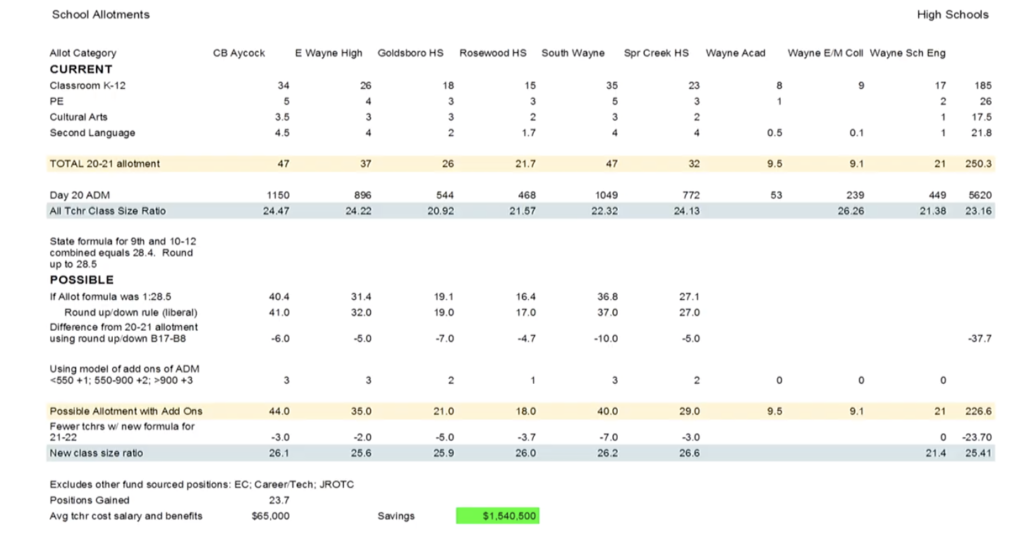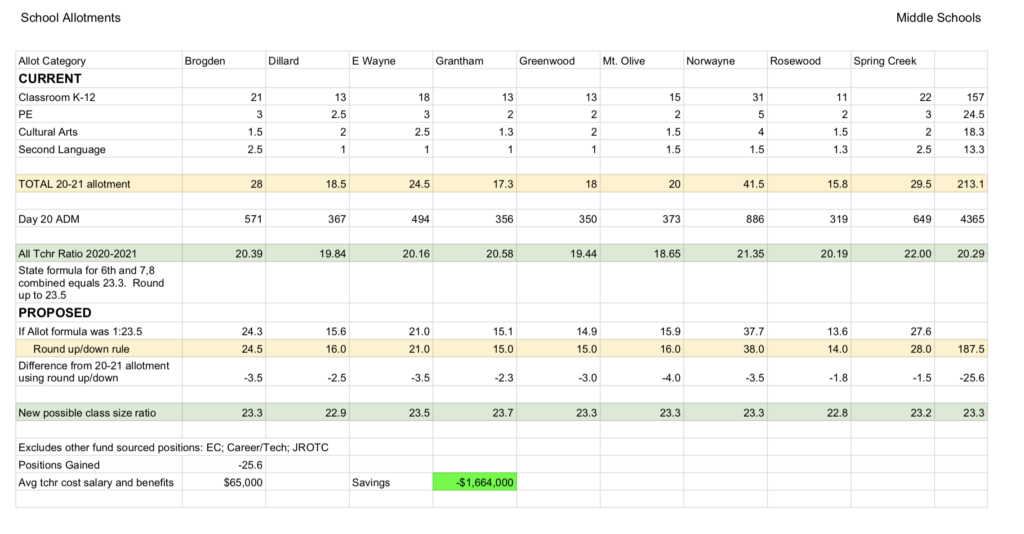Wayne County Public Schools will need to cut teachers’ jobs at nearly every school in the county to begin to overcome a $2.4 million budget deficit and to pay back a $2.1 million state loan, which is accruing $20,000 in interest a month, officials told the Board of Education Monday.
Also included on that list of cuts is a change to the stipend offered to teachers each year.
The district’s deficit is “probably the worst I have ever seen,” Adam Scepurek of Anderson, Smith and Wike PLLC, told board members at the special called meeting.
“This is a significant deficit,” Scepurek said.
By law, the district cannot operate with a deficit without a plan for repayment.
“The state has laws to encourage you to not spend what you don’t have,” he said.
In addition to resolving the loan from the state, the district will also have to immediately begin to repay the $3 million loan from its Child Nutrition Fund, one of the discoveries in the budget discussions last school year that led to questions about then-Superintendent Dr. Michael Dunsmore and former finance officer Michael Hayes.
“This is a federally funded program,” Scepurek said. “They will want that back as soon as possible.”
The new auditor’s comments came as Acting Superintendent Dr. James Merrill made his final recommendations to the board regarding the district’s budget considerations.
Merrill’s last day as the leader of WCPS is Friday. Dr. David Lewis, acting superintendent for technology and accountability, will act in the interim role, as the board voted to reopen the application process and to continue the search for a new superintendent.
The presentation of the preliminary audit — there is still more analysis to be done, Scepurek said — included a discussion of the district’s actual financial position and previous “violations” that contributed to the incomplete financial picture.
The auditor said that salaries — and significant increases in that line item over the years — are one of the main reasons for the deficit.
He said that moving forward, the district will have to consider that just maintaining the state allotment of teachers is not enough.
“Salaries are the No. 1 expenditure,” he said. “It is the driver of expenditures and the No. 1 place to look to mitigate the deficit.”
Consideration will have to be given to the additional costs — health insurance, retirement allocations — which take a bite out of the budget each year, when considering how many positions to fund, he added. Other districts take those benefit costs into account when budgeting.
“They are having to cut positions just to break even,” Scepurek said.
Among the auditor’s findings were decisions to fund expenditures without corresponding moneys to pay for them, which prompted deficit spending that ate up a more than $7 million fund balance and set up the conditions that resulted in the current massive debt.
The auditor’s report was the first step, along with revamping of the district’s financial reporting, practices and procedures, to getting a workable budget plan moving forward.
Aaron Beaulieu of School Operations Specialists has been working with the district to finish out the 2020-21 school year and to start budget work for 2021-22. His firm has been retained to continue that work on a limited basis.
But during his comments and analysis of where the district is now, Merrill made it clear that the next step for Wayne County Public Schools should be getting its staffing in line with the state allotment and cutting back on expenses to pay down the budget deficit as well as the $2.1 million Department of Public Instruction loan taken out to make June payroll and an outstanding $3 million loan from the Child Nutrition Fund.
Bottom line, Merrill told the board, the district is overstaffed based on state allotment numbers of teachers (the number funded by the state).
“If high schools were staffed at just the state allocation formulas, then we are overstaffed by 37 positions at the high schools,” he said.
The same is true at the district’s middle and elementary schools — 25 at middle schools and 23 at elementary schools, Merrill added.
The district does offset some of those extra staff expenses through use of low-wealth funds, which allow the county to hire more teachers beyond the number allotted by state funds, which means getting to that state allotment number would not take draconian cuts.
Merrill suggested that elementary schools should use state formulas for core teachers — those who teach major subject areas — and allot for physical education, cultural arts and English as a Second Language.
At the middle school and high school levels, school principals will be given a centralized allotment amount — a number of teachers that can be hired at the school — and then be permitted to make those assignments as they see fit based on the individual needs of the schools.
High schools, however, would be given additional teachers based on their Average Daily Membership — an additional position for less than 500 ADM; two positions for 500-900; and three positions for 900 and above.
The allotment pool would give principals more flexibility and would force them to use their hires wisely, while controlling costs.
“There would be no saying, ‘I need an additional PE teacher,’” Merrill said.
Although the numbers are stark, Merrill said the actual application is not quite so dire.
The position cuts per high school would range from 2 at Eastern Wayne; 3 each at Spring Creek and Charles B. Aycock and 3.7 at Rosewood to 5 at Goldsboro and 7 at Southern Wayne.
Here are the charts for the proposed cuts at the middle and elementary schools as well as the complete high school breakdown:



Merrill said some of those cuts could be offset by retirements or resignations, with some schools not only covering the reductions, but ending up with open positions that could be filled through teacher transfers from other schools or new hires.
The acting superintendent’s plan also includes a proposal, which was already presented to the board, that the district non-renew its beginning teachers (1 and 2), which would result in the release of 121 teachers.
At Monday’s meeting, Merrill said that he was able to come up with enough funding to justify retaining one or two exemplary beginning teachers at each school and allowed waivers for Exceptional Children teachers and beginning teachers at the two lowest performing schools in the county — Dillard Middle and Brogden Middle.
That saved 43 beginning teacher positions. Should the district have positions open, beginning teachers would be eligible for rehire, Merrill added, but the district would need to make sure position reductions were satisfied before any rehiring could occur.
According to the monthly calendar Merrill left with the board, principals would look at staffing and potential teacher transfers in early 2021, with actual overstaffing and beginning teacher cuts and waivers in March and April, taking into consideration potential retirements and resignations.
Schools would be able to hire up to their allotments once the budget has been reconciled and the $2.5 million in savings confirmed.
But the positions that are ultimately cut will not come back.
“These have to be permanent reductions,” Merrill said. “You are over budget and overstaffed.”
The position cuts are not the only concerns involving teachers.
The district has already changed from paying teacher supplements in a lump sum twice a year to dividing those payments up monthly. The second prong of that savings plan would change those supplements from a percentage of salary to a flat, lump sum.
The proposal also includes an increase in class sizes, also discussed previously, across all schools.
Merrill’s proposal is still just a recommendation at this point.
Board members will have to make decisions about how to whittle away the debt and how to repay the state loan in the coming months, with a firm budget expected early next year.


Isn’t the teacher supplement paid by county commissioners? If the commissioners hand over the money for those supplements, why is that money being touched at all? It should be there for payment to teachers and wcps shouldn’t be touching it otherwise.
Probably just a way to repurpose some of those funds on typical waste instead of compensating teachers
Is the county also over staffed in the Central Office? Seems like that would be a good place to start cutting.
Why not cut positions at the county office, not fill retirement positions to save teachers? Adjust salaries, supplements, other monetary benefits at the county level. Protect the people teaching the children. The people that are currently on the front line of a pandemic going everyday teaching the best they can in a tough situation.
I’ve come to the conclusion that Wayne County and it’s politicians, “board members” and such are crooked as crooked can get.